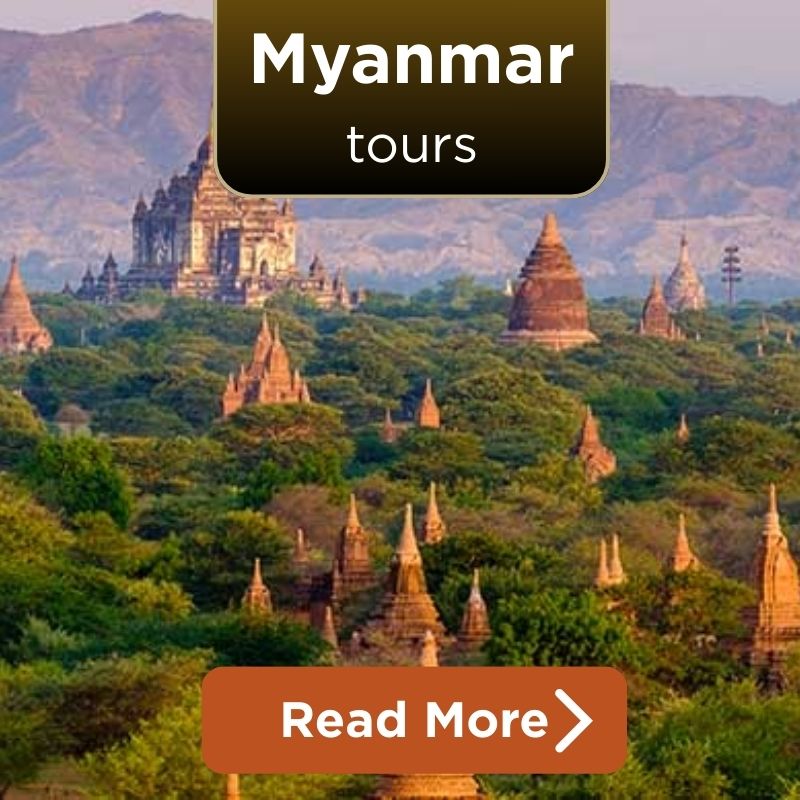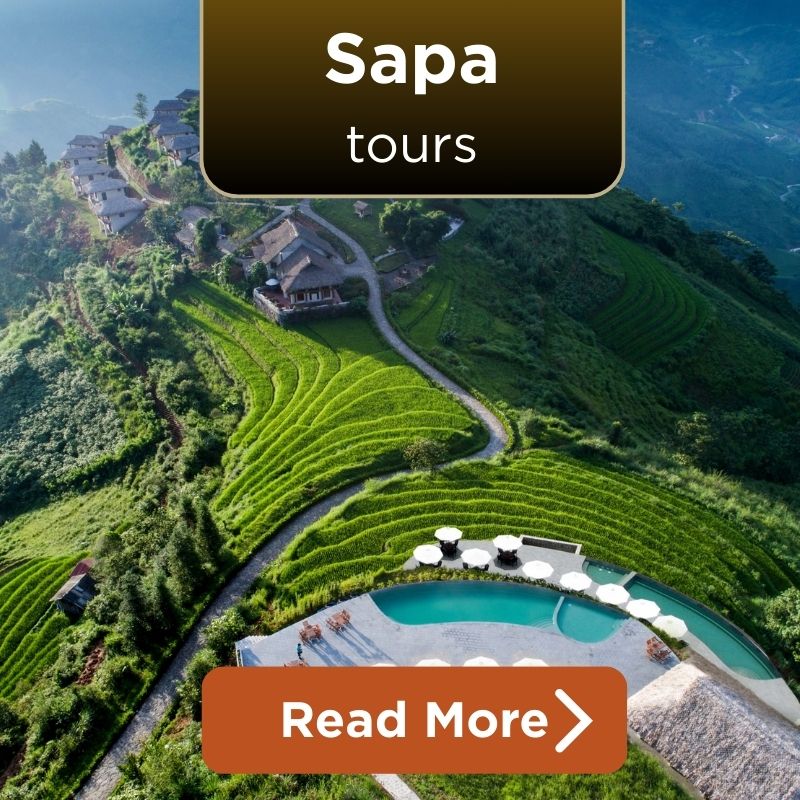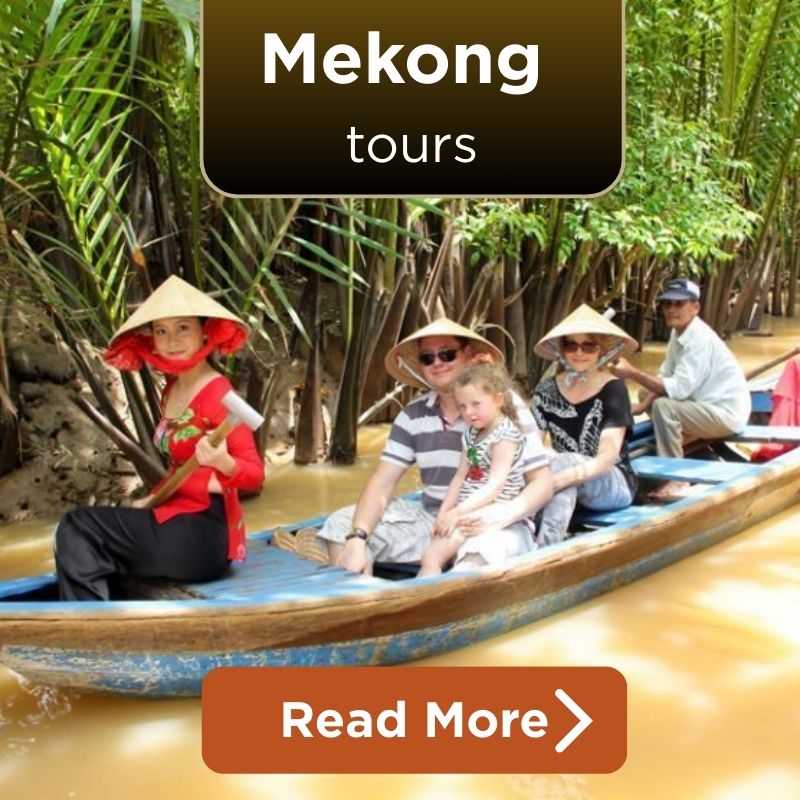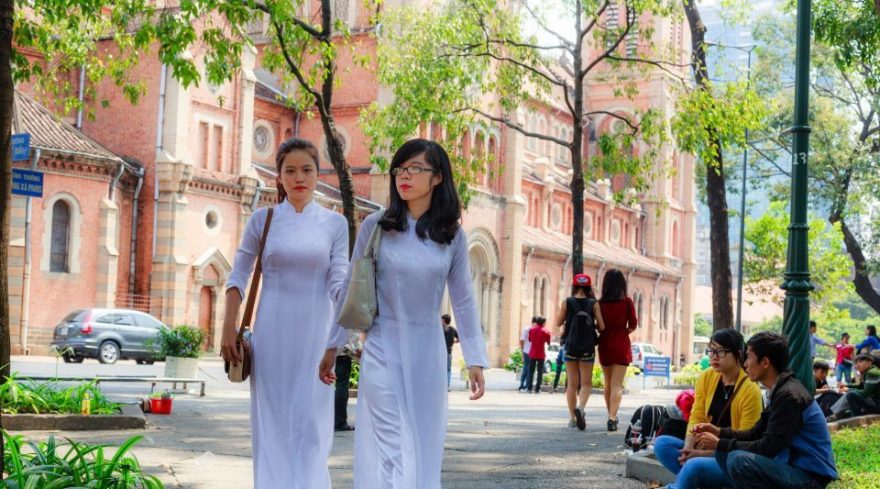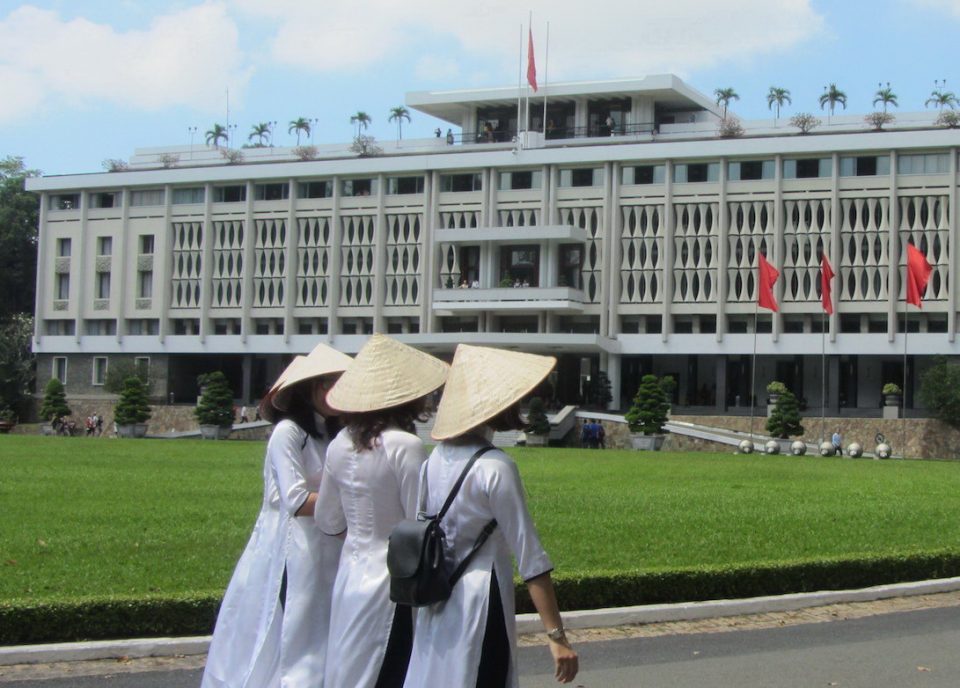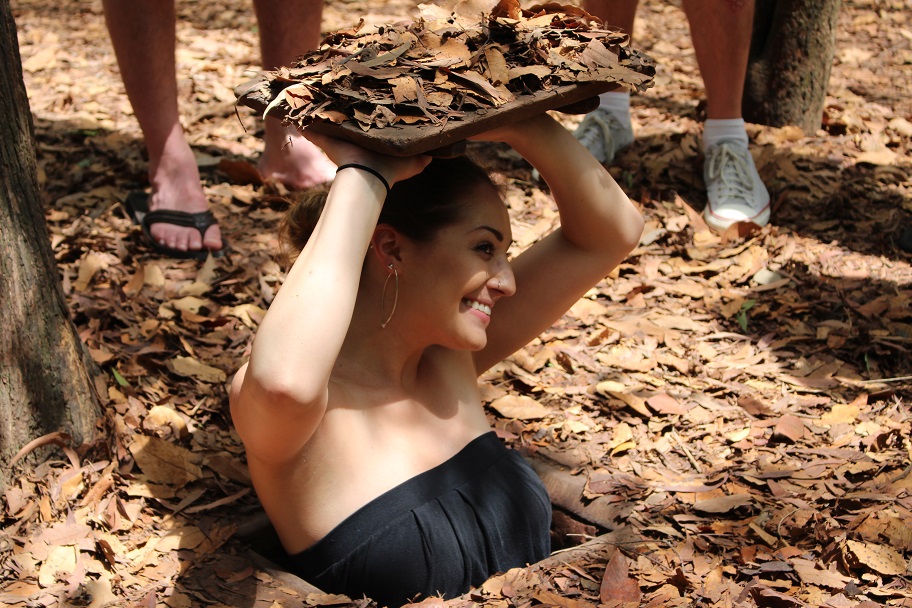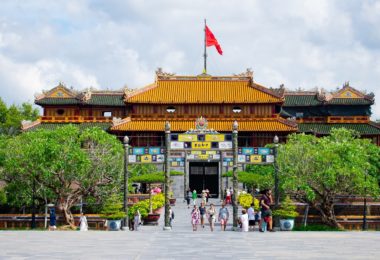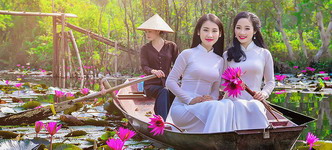For those exploring on an HCM city Buddhassava tour, Chua Quan Am is a must-see. This guide touches upon it all, from its inspiring history and culturally distinct architecture down to the colorfully ritualistic Buddhist rituals and festivals that take place. As we journey through its storied halls and learn these ancient customs still in practice here, let us unlock the true beauty of Chua Quan Am together.
Historical Background of Chua Quan Am on HCM city Buddhassava tours

Chua Quan Am (Sours: localvietnam)
Founding and Origins
Founded in 1965 by the dedicated Venerable Thich Nu Hue Tuyen, Chua Quan Am on Lao Tu Street, Ward 11, District 5, Ho Chi Minh City, was to be a haven for spiritual growth and contemplation. Constructed with the express purpose of providing a haven where the community could delve deep into Buddhist preaching, Chua Quan Am has been a treasured spot for anyone seeking peace and enlightenment ever since.
Evolution Over Time
In 2018, the temple received major renovations with the generous support of the local government and active community members to return it to its beauty and safety for its increasingly growing community of devotees. It rejuvenated, keeping its original design and much-needed strengthening in the modern world. On HCM city Buddhassava tours are the revitalized Chua Quan Am, representing a new outlook on Vietnamese spirituality within a historically spiritual site. Another well-known pagoda is Quan Am Pagoda; this is also one of the older ones, located in Cholon and thus bringing its history to light, establishing District 5 as a center where the Buddhist sway is strong and long-lasting.
Chua Quan Am’s Role in Vietnamese Buddhism
Chua Quan Am is related to Northern Mahayana Buddhism and has developed to become a beacon for Vietnamese Buddhists, reflecting a sense of compassion, wisdom, and peace in this busy city. The pagoda serves very much as an educational and spiritual treasure for many on HCM city Buddhassava tours, hosting numerous meaningful ceremonies and festivals. Highly noted among them are the Vu Lan Festival, held to show gratitude to ancestors, and Vesak, a commemoration of Buddha’s birth, events that attract thousands every year in a unique cultural experience that combines tradition and necessary community bonding.
Architectural and Cultural Significance on HCM city Buddhassava tours

Offer incense (Sours: vietnam-destinations)
Architecture of Chua Quan Am
The architecture of Chua Quan Am, representative of the striking fights between the traditions of both Vietnamese-Chinese, is a typical feature in most travelers on Ho Chi Minh City tours who want to seek cultural immersion. In every corner, this pagoda is considered a masterpiece: a bright, red-tiled roofs, high-topped wooden pillars, and a peacefully embellished courtyard telling tales of Buddhist aesthetics and its cultural fight in Vietnam.
Main Halls and Shrines
The main shrine greets you upon coming in, the most breathtakingly beautiful place, with statues of the Buddha and Avalokiteshvara, the Bodhisattva of Compassion, adorning the halls. Each statue and all the halls signify virtues of compassion and salvation, upon which a visitor is invited to ponder. From the delicacy of the lotus motifs to the majesty of the depicted Buddha, every piece calls out for deep connectivity with Buddhist teachings.
Symbolic and Artistic Elements
Various carvings, statues, and decorations around Chua Quan Am provide a visual narration of the principles of Buddhism that inspire and educate. The symbols of dragons and lotus flowers hold very important meanings in Buddhism to depict resilience and spiritual purity. It is these touch-and-go artistic elements that make Chua Quan Am a living heritage site, putting ancient traditions in touch with today’s admirers.
Cultural Heritage Preservation
Chua Quan Am stands proud, guarding the cultural heritage that bridges the centuries of Buddhist traditions and today’s practices in Vietnam. The iconic pagoda, well-preserved for generations, has turned into an invaluable spot to spend time on HCM city Buddhassava tours, combining visitors with the undying spirit of Vietnamese Buddhism and its ever-evolving practice.
Spiritual Experience and Buddhist Rituals on HCM city Buddhassava tours

Lunar New Year (Sours: abcnews)
Key Buddhist Practices at Chua Quan Am
Meditation sessions, chanting gatherings, and teaching enlightenments take place within the serene halls of Chua Quan Am and regularly introduce visitors to traditional Buddhist practices. Visitors on an HCM city Buddhassava tour get to experience these meditative practices and, from within, learn how they capture the essence of Buddhist teachings. Many minds find repose in these quiet moments, the reverberations of ancient wisdom seeming to flow through the halls.
Annual Festivals and Events
Various festivals are organized throughout the year in Chua Quan Am; they form highly important events not only in terms of religion but also as vibrant cultural events. The highlights include:
- Vesak: It celebrates the birth, enlightenment, and death of Buddha. During Vesak, a host of Chua Quan Am people participate by chanting, meditating, and presenting offerings.
- Lunar New Year: The pagoda is decorated with flowers and becomes colorful, attracting tourists who want to see traditional New Year’s blessings.
- Vu Lan Festival: Commonly referred to as the “Day of Filial Piety" in honor of ancestors. Locals and tourists gather here; thus, this festival obtains the reputation of being one of the most outstanding cultural displays
Each of these festivals offers a different window into Buddhist customs and Vietnamese culture, making it unskippable for the visitors of Ho Chi Minh City tours to witness the depth of local spiritual life.
Visitor Participation in Rituals
One impressive thing about Chua Quan Am while visiting an HCM city Buddhassava tour is observing or participating in respective religious rituals. Visitors are encouraged to show their respects by participating in chanting sessions, offering incense, or simply observing with much reverence. Some useful etiquette tips:
- Dress modestly: Several long sleeves and respectful attire are highly valued.
- Silence: Keep low voices so that people will be able to listen and focus on the prayers.
- Engage mindfully: Although participation can be familiar in the company of those who join in, even watching is a powerful experience for those unfamiliar with Buddhist customs.
HCM City Buddhassava Tours: Pagoda Highlights

Vu Lan Festival (Sours: travelvietnam)
Sacred Statues and Icons
Every sanctuary statue and icon that you will witness in the exploration of Chua Quan Am on your HCM city Buddhassava tour is filled with deep spiritual meaning. These statues- from peaceful Buddha to compassionate Avalokiteshvara an important role in Buddhist teachings and conjure reverence among worshippers. The statues inside Ho Chi Minh City tours often attract visitors for both their artistic value and deep representations.
Gardens and Courtyards
The gardens and courtyards in Chua Quan Am serve as hidden sanctuaries of tranquility, enabling reflection amidst the city bustle. Take a stroll through lush greenery, serene ponds, and nicely kept pathways. Such serenity, filled with incense, allows visitors to pause and connect with nature. This is one of the highlights for visitors who want to remember this day more contemplative on their HCM city Buddhassava tour.
Unique Customs
One such tradition that visitors might encounter is the “Beating the Villain" ritual, deeply enriching the cultural significance of the Chinese. This is an acting ritual where people free themselves from bad energies or “villains" in their lives by creating a paper figure of the same “villains" and then tapping it lightly with something to “beat" it as an act of ridding oneself of all the bad luck. Those taking the HCM city Buddhassava tour may find this an interesting tradition since it affords a look at the meeting between spirituality and local cultural practices at Chua Quan Am.
Visiting Chua Quan Am: Practical Information For HCM City Buddhassava Tours

Ho Chi Minh Temple (Sours: TripSavvy)
How to Get There
Agreeing with Chua Quan Am is not an issue – there are a few possibilities:
- By Bus: 1, 11, 27, 34, 38, 45, 50, 65, 93, 139 to Nguyen Van Cu – Lao Tu station, from here follow the road on the left for about 100 m to the address Chua Quan Am.
- By Car or Motorcycle: Take the more hassle-free option and head down Nguyen Trai onto Nguyen Van Cu and take a right onto Lao Tu Street.
- Best Time to Visit: It is best to visit in the morning or early afternoon when the atmosphere is quiet, and one can witness local Buddhist rituals.
This accessibility makes Chua Quan Am a must-see at Ho Chi Minh City tours, offering a cultural respite just minutes from downtown.
Visitor Etiquette and Guidelines for HCM City Buddhassava Tours
To show regard for the sanctity of Chua Quan Am, here are some etiquette tips:
- Dress Respectfully: Respect given to cover the shoulders and knees is valued.
- Behavior: Be quiet and respect others, as many people come here for reflection and prayer.
- Photography: photography is permitted, but no flash inside the shrine, please; if monks or local worshippers are to be included in your shots, always ask permission.
Accessibility on HCM City Buddhassava Tours
Chua Quan Am is accessible to visitors of all types, whether in wheelchairs or otherwise. Indeed, the temple grounds have wheelchair-friendly paths, and many HCM city Buddhassava tours offer a tour guide who will support the visitor if they have special requirements, hence allowing each different type of visitor to take the serenity of this pagoda.
Neighboring Cultural Sites for HCM City Buddhassava Tours
Exploring Nearby Attractions
A visit to Chua Quan Am in District 5 offers an exciting opportunity to explore other cultural landmarks nearby:
- Older Quan Am Pagoda (Cholon): It is older, and of a higher historical and spiritual value, with traditional architecture and its unique role in Ho Chi Minh City’s Buddhist community.
- District 8 Highlights: Local markets, temples, and parks combined give an all-rounded feel to this place, ideal for Ho Chi Minh City tours seeking a blend of history and spirituality with a streak of local flavor.
Food and Souvenirs on HCM City Buddhassava Tours
Nearby, vegetarian dining options to the Buddhist lifestyle philosophy, while gift shops sell Buddhist icons, amulets, and locally-made souvenirs. These are good keepsakes for anyone wanting something for a memento of their journey on the HCM city Buddhassava tour.
Chua Quan Am’s Role on HCM City Buddhassava Tours
Importance for HCM City Buddhassava Tours
As the center of HCM city Buddhassava tours attract both domestic and foreign Buddhist tourists, Chua Quan Am offers insightful guided tours that allow visitors to deeply understand the Buddhist culture and meaningfully connect with the teaching and history of the temple. To the Buddhist tourist, Chua Quan Am stands as a powerful reminder of compassion, resilience, and spiritual wisdom.
Supporting Spiritual Tourism in Ho Chi Minh City
Chua Quan Am plays an important part in the development of Ho Chi Minh City’s sustainable and respectful spiritual tourism. The commitment of the Temple to safeguarding cultural traditions, and care for the environment, exemplifies in itself the values of responsible tourism that HCM city Buddhassava tours are striving for. This orientation toward sustainability will enhance the experiences of visitors and will continue, making the pagoda a sanctum sanctorum for generations to come.
Community and Outreach Programs
HCM city Buddhassava tour visiting the site can also join the community programs that the temple arranges. Chua Quan Am has been skilled at building bonds with the community for years, which enables charitable undertakings such as the distribution of aid to poor families, disaster relief, and educational seminars. Such programs not only serve the community but also present opportunities for tourists to give something in return: enrich their experience and further their learning about the values of Buddhism.
Conclusion
Chua Quan Am is not only an attractive landmark but a living witness of culture and spirit within the heart of Ho Chi Minh City. Rich heritage, profound architecture, and well-rooted traditions guarantee indelible impressions to every visitor. To all visitors going on an HCM city Buddhassava tours, a visit to Chua Quan Am not only visually teaches about Buddha but takes them into the core of Vietnamese culture.









